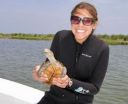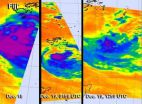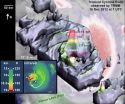(Press-News.org) WORCESTER, MA – Promising new research provides evidence that ALS, amyotrophic lateral sclerosis (ALS), also known as Lou Gehrig's disease, may be treatable using neural stem cells. A consortium of researchers at multiple institutions, including the University of Massachusetts Medical School, Sanford-Burnham Medical Research Institute and Brigham and Women's Hospital, have shown that neural stem cells, when transplanted into the spinal cord of a mouse model with familial ALS, slow disease onset and progression while improving motor function, breathing and survival time compared to untreated mice. A summary of the studies was published online in Science Translational Medicine.
ALS is a progressive, neurodegenerative disorder affecting the motor neurons in the central nervous system. As motor neurons die, the brain's ability to send signals to the body's muscles is compromised. This leads to loss of voluntary muscle movement, paralysis and eventually respiratory failure. The cause of most cases of ALS is not known.
Approximately 10 percent of cases are inherited. Though investigators at UMass Medical School and elsewhere have identified several genes shown to cause inherited or familial ALS, almost 50 percent of these cases have an unknown genetic cause.
Neural stem cells are the precursors of all brain cells. They can self-renew, making more neural stem cells, and differentiate, becoming nerve cells or other brain cells. These cells can also rescue malfunctioning nerve cells and help preserve and regenerate brain tissue. But they've never before been studied extensively in a good model of adult ALS.
In 11 independent studies, the group, headed by Dr. Evan Snyder of the Burnham Institute, transplanted neural stem cells into the spinal cord of a mouse model of ALS. The transplanted neural stem cells benefited the mice with ALS by preserving the health and function of the remaining nerve cells.
Specifically, the neural stem cells promoted the production of protective molecules that spared remaining nerve cells from destruction. They also reduced inflammation and suppressed the number of toxin-producing and disease-causing cells in the host's spinal cord.
"It is striking that the stem cells improve motor neuron viability without generating new motor neurons. These findings encourage us to explore further the role of cell therapies in ALS," said Robert Brown, MD, DPhil, a co-author on the study and chair of neurology at UMass Medical School. A leading expert in ALS, Dr. Brown led the team that discovered the first gene linked to familial ALS, a protein anti-oxidant known as superoxide dismutase, or SOD1 in 1993.
###
This research was funded by Project ALS, California Institute for Regenerative Medicine, the U.S. National Institutes of Health (National Institute of Neurological Disorders and Stroke grants R21NS053935, 1RC2NS070342-01, 1RC1NS068391-01, R01NS050557-05, U01NS05225-03), U.S. Department of Veterans Affairs, Christopher Reeve Foundation/American Paralysis Association, Project ALS, P2ALS, Sanford Children's Health Research Center, Zinberg Foundation, ALS Therapy Alliance, ALS Association, Angel Fund, Al-Athel Foundation, Pierre L. deBourgknect ALS Research Foundation, and HeadNorth.
About the University of Massachusetts Medical School
The University of Massachusetts Medical School has built a reputation as a world-class research institution, consistently producing noteworthy advances in clinical and basic research. The Medical School attracts more than $250 million in research funding annually, 80 percent of which comes from federal funding sources. The work of UMMS researcher Craig Mello, PhD, an investigator of the prestigious Howard Hughes Medical Institute (HHMI), and his colleague Andrew Fire, PhD, then of the Carnegie Institution of Washington, toward the discovery of RNA interference was awarded the 2006 Nobel Prize in Physiology or Medicine and has spawned a new and promising field of research, the global impact of which may prove astounding. UMMS is the academic partner of UMass Memorial Health Care, the largest health care provider in Central Massachusetts. For more information, visit www.umassmed.edu.
Transplanted neural stem cells slows als onset and progression in mouse models
2012-12-20
ELSE PRESS RELEASES FROM THIS DATE:
Study reveals that animals contribute to seagrass dispersal
2012-12-20
(December 19, 2012) Look out the window and you're likely to see the dispersal of seeds—dandelion tufts in the wind, a squirrel burying an acorn, a robin flying off with a dogwood fruit. You might even have a burr "velcroed" to your sock.
Sarah Sumoski, a recent graduate of the Virginia Institute of Marine Science, has now published a study of seed dispersal in a less-familiar environment—the eelgrass beds of Chesapeake Bay. The study—the first to show that marine animals can disperse eelgrass seeds—appears as the featured article in today's issue of Marine Ecology Progress ...
Time series of infrared NASA images show Cyclone Evan's decline
2012-12-20
Cyclone Evan is now far south of Fiji and wind shear and cooler sea surface temperatures have been taking their toll on the storm and weakening it. Infrared data from NASA's Aqua satellite has shown a quick decline in the storm's structure over one day.
A time series of infrared images from the Atmospheric Infrared Sounder (AIRS) instrument that flies aboard NASA's Aqua satellite showed changes in intense thunderstorms within Cyclone Evan between Dec. 18 and Dec. 19. Over a time period of 36 hours, Evan weakened from Cyclone strength to Tropical Storm strength. In an ...
NASA satellite finds an unusually tall storm-cell in Cyclone Evan
2012-12-20
NASA's Tropical Rainfall Measuring Mission or TRMM satellite found an unusually tall towering thunderstorm in Cyclone Evan.
According to Owen Kelley of the TRMM satellite team at NASA's Goddard Space Flight Center in Greenbelt, Md, the most startling feature of the December 16 overflight of Tropical Cyclone Evan was the extremely tall storm-cell in the north side of the eyewall. At the time TRMM passed overhead and captured an image of the storm, Evan was about to rake across the northern coast of the islands of Fiji.
The updrafts in this tower extended high enough ...
Why our backs can't read braille
2012-12-20
Johns Hopkins scientists have created stunning images of the branching patterns of individual sensory nerve cells. Their report, published online in the journal eLife on Dec. 18, details the arrangement of these branches in skin from the backs of mice. The branching patterns define ten distinct groups that, the researchers say, likely correspond to differences in what the nerves do and could hold clues for pain management and other areas of neurological study.
Each type of nerve cell that the team studied was connected at one end to the spinal cord through a thin, wire-like ...
NASA's Operation IceBridge data brings new twist to sea ice forecasting
2012-12-20
Shrinking Arctic sea ice grabbed the world's attention again earlier this year with a new record low minimum. Growing economic activity in the Arctic, such as fishing, mineral exploration and shipping, is emphasizing the need for accurate predictions of how much of the Arctic will be covered by sea ice. Every June, an international research group known as the Study of Environmental Arctic Change (SEARCH) publishes a summary of the expected September Arctic sea ice minimum known as the Sea Ice Outlook. The initial reports and monthly updates aim to give the scientific community ...
LSUHSC research discovery provides therapeutic target for ALS
2012-12-20
New Orleans, LA –Research led by Dr. Udai Pandey, Assistant Professor of Genetics at LSU Health Sciences Center New Orleans, has found that the ability of a protein made by a gene called FUS to bind to RNA is essential to the development of Amyotrophic Lateral Sclerosis (ALS). This discovery identifies a possible therapeutic target for the fatal neurological disease. The research will be available online in the Advanced Access section of the journal Human Molecular Genetics website, posted by December 21, 2012. It will be published in an upcoming issue of the journal.
...
Small changes in eating prompts weight loss
2012-12-20
Making small easy changes to our eating habits on a consistent basis - 25 days or more per month - can lead to sustainable weight loss, according to research by Professor Brian Wansink in Cornell University's Food and Brand Lab. The challenge is to figure out which changes work for specific individuals and how to stick with changes long enough to make them second nature.
To explore this issue, Cornell researchers launched the National Mindless Eating Challenge (NMEC), an online healthy eating and weight loss program that focused on simple eating behavior changes, instead ...
MicroRNAs present exciting opportunities for cancer therapy and diagnosis
2012-12-20
Amsterdam, NL, December 19, 2012 – As many as 50 percent of all human protein-coding genes are regulated by microRNA (miRNA) molecules. While some miRNAs impact onset and progression of cancer, others can actually suppress the development of malignant tumors and are useful in cancer therapy. They can also serve as potential biomarkers for early cancer detection. In a new issue of Cancer Biomarkers, investigators report on non-coding miRNAs as appealing biomarkers for malignancy.
"MiRNA-based therapies are attractive partly due to the fact that these molecules can target ...
California's graduate students in environmental sciences lag behind in technology, computation
2012-12-20
RIVERSIDE, Calif. — Researchers at the University of California, Riverside have conducted a study showing that many skills and practices that could help scientists make use of technological and computational opportunities are only marginally being taught in California's formal graduate programs in the environmental sciences.
The researchers found, too, that graduate students in the state were, in general, not engaged in data management practices. Of the students surveyed who had already completed their graduate degree, only 29.3 percent had made their research data products ...
Delusions of gender: Men's insecurities may lead to sexist views of women
2012-12-20
He loves her, he loves her not.
A new study led by Joshua Hart, assistant professor of psychology, suggests that men's insecurities about relationships and conflicted views of women as romantic partners and rivals could lead some to adopt sexist attitudes about women.
The study was recently published in Personality and Social Psychology Bulletin, a peer-reviewed journal.
Hart and his co-authors, Jacqueline Hung '11, a former student of Hart's, and psychology professors Peter Glick of Lawrence University and Rachel Dinero of Cazenovia College, surveyed more than 400 ...





